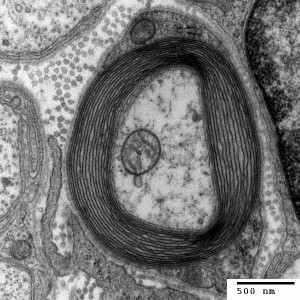What is the nervous system?

Cross-section of a myelinated neuron.
The nervous system consists of the motor neurons and sensory neurons, the central nervous system and the peripheral nervous system. One set of nerves carries messages from the brain outward to the rest of the body and one brings messages from the extremities back to the brain. Messages that travel from the brain down the spinal cord, through the lower motor neurons (such as the sciatic nerve of the leg) to the muscles of the body are part of the motor neuron circuitry. Messages that travel upward from the sensory input to the spinal cord and finally the brain are sent by sensory neurons. The central nervous system consists of the brain and spinal cord. The peripheral nervous system consists of all of the nerves that branch off the central nervous system and extend to the feet and hands, and since CMT affects the peripheral nerves, it usually results in both motor symptoms (weakness and muscle wasting) and sensory symptoms (numbness). CMT is called a neuromuscular condition because it is the failure of the nerves that cause the malfunctioning of the muscles (unlike muscular dystrophy which affects the muscles themselves).
What are the peripheral nerves?
Peripheral nerves that control muscle movement are often described as being like electrical wires. Each nerve contains bundles of nerve fibers, with an inner core (the axon) that passes signals to muscles causing them to move. The axon is wrapped in insulation (the myelin sheath). When the myelin is damaged (CMT Type 1 and Type 4), the nerve impulses are conducted more slowly than normal. If the axon itself is damaged (CMT Type 2), the speed of nerve conduction is almost normal, but the strength of the signal is reduced. Both result in impaired electrical messaging to the muscles and therefore malfunctioning of the muscles (weakness and eventual wasting away).





